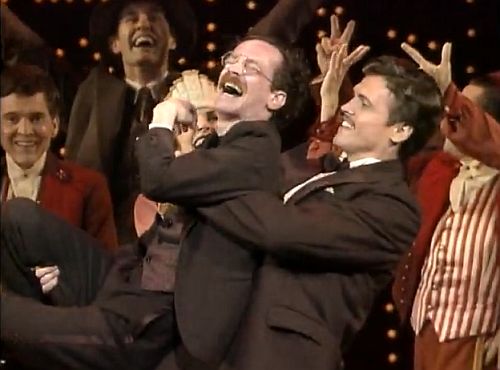Agatha Rex by Lindsay Price is a bold high school take on Antigone - packed with heart, conflict, and a powerhouse ensemble. One girl. One stand. One huge risk. *NEW COMPETITION VERSION AVAILABLE!*
Choreography for Guys
Episode 14 – YouTube Fireside Chat – Choreography for Guys
Today we’re talking choreo for guys on the YouTube Fireside Chat. The key is that it has to be character-driven. We’ve chosen a couple of specific numbers to talk about.
How to Succeed in Business Without Really Trying
Catch Me If You Can
Grand Hotel
https://www.youtube.com/watch?v=zDc9ul70kyY
Show Notes
Subscribe to The Theatrefolk Podcast in iTunes by CLICKING HERE.
Episode Transcript
Lindsay: Welcome to TFP, The Theatrefolk Podcast. I am Lindsay Price, resident playwright for Theatrefolk. Hello. I hope you’re well. Thanks for listening.
Today, it’s another YouTube Fireside Chat with the one, the only, Craig Mason. But first, let’s do some Theatrefolk news.
Theatrefolk is going to have an information table at the Virginia Theatre Association Festival this weekend, Friday, October 23rd and Saturday, October 24th in Reston, Virginia. Catalogues, free resource information, and we’ll be handing out our play-tasting CD-ROM, which has sample pages from every one of our plays on it. That’s right, every single one of our plays at your fingertips. How exciting!
And what’s even more exciting is that there’s going to be a guest at the Tfolk table, playwright Bradley Walton, who hails from the area, is going to be at the booth on Saturday the 24th with samples from his plays, The Absolutely Insidious and Utterly Terrifying Truth About Cat Hair, and two new ones, The Baloney, the Pickle, the Zombies, and Other Things I Hide From My Mother, and Storied. Drop by, say hi.
Lastly, where, oh where can you find this podcast? We post new episodes every Wednesday at Theatrefolk.com and our Facebook page and Twitter. You can find us also on the Stitcher app, and you can subscribe to TFP on iTunes. All you have to do is search on the word “Theatrefolk.”
Welcome to our YouTube Fireside Chat, where Craig and I snuggle up to the microphone and talk about musical numbers that you can find on YouTube. And today—very excited about today—today we are looking at choreo for guys. From a school perspective, it’s usually harder to get guys to dance, and our three videos today are really great examples of character dancing. It’s not about ballet or the box step. It’s about, really, all you have to do is move in character. Wouldn’t you say so?
Craig: Yeah. Yeah. And these are three really great examples of men dancing, and…
Lindsay: And looking really manly. [Laughs] You know?
Craig: [Laughs] And being masculine and being true to their characters. There’s nothing worse than when you come to a dance number and all of a sudden everyone’s running around moving like dancers rather than their characters.
Lindsay: Well, I think we said this the last time we did this. There was Newsies, which is new on Broadway, and they showed that clip from the Tonys, and all of a sudden everyone looks like they had been to 12 years of dance training.
Craig: Yeah, I mean, I find that stuff really… [Laughs] We’re going to go off on a tangent here so early in podcast…
Lindsay: Oh, my goodness.
Craig: But I find that so bothersome. You’re right. When everyone all of a sudden is like an amazing dancer—some characters can be slow. Some characters can be confused. Some characters can be more dominant. But in shows like that, when all of a sudden everyone is this amazing perfect dancer, it just doesn’t work for me because it doesn’t make any sense.
Lindsay: Well, it takes me out of the world, and I think that’s what some people think, is that, “Oh, everything has to be perfect.” And it’s like, not really. It all has to be character-driven.
Craig: Not if I’m in the audience.
Lindsay: That’s exactly right. And of course, you’re in the audience for every show all the time.
Craig: [Laughs] No, I’m not. I’m not.
Lindsay: Oh, okay. Yes. We’d never get any work done.
Craig: Let’s move on.
Lindsay: So our first clip is from How to Succeed in Business Without…oh my goodness, Craig, is it Without Really Trying or Without Trying?
Craig: Without Really Trying or Without Even Trying?
Lindsay: [Sings] La, la, la, la, la. La, la, la, la, la.
Craig: [Sings] The brotherhood of men.
Without Really Trying.
Lindsay: Okay, How to Succeed in Business Without…
Craig: You want to restart that or you want to just have this terrible flaw in the middle of our podcast?
Lindsay: Hmm, you know what? Let’s have a terrible flaw.
Craig: Okay.
Lindsay: We’re flawed. See? Even here at Theatrefolk Global Headquarters, we are not perfect, just like the dancing. So, How to Succeed in Business Without Really Trying, and this is the most recent remount with Daniel Radcliffe in the title role. And I think the first thing to point out is that Daniel Radcliffe is neither a singer nor a dancer.
Craig: No. I mean, he…
Lindsay: He’s fine.
Craig: He sings decently and he moves decently, but I think he works quite well in this.
Lindsay: I know. And what I find really great about this is, first of all, there are two things going on. There is a story going on in that the Daniel Radcliffe character is trying to evoke, well, a brotherhood of men. That’s the scene we’re looking at.
Craig: Yeah. I don’t know this show too well but, I mean, the story I get is that he’s trying to convince the big boss not to fire John Larroquette by basically saying, “Hey, we’re all bros. It’s like the man code here. We look out for each other.”
Lindsay: So he’s trying to evoke a feeling, and that by evoking that feeling it takes a while for everyone to be on board. They’re kind of reluctant at first.
[Song excerpt plays]
Craig: Well, what I like is that the choreography, especially at the beginning, is a lot like puppetry. It looks like Daniel Radcliffe’s character is manipulating the movements of the other characters. It looks like he’s controlling what they do, and that was really clearly what the intention was.
Lindsay: Mm-hmm. There are some other really smart things in it, too, in that the choreographer really focused on levels and shapes. This choreographer is not [song excerpt plays] afraid to throw these dancers down on the floor. There’s lots of rolling, there’s lots of leaping, they kind of jump all over each other, and it’s not pretty movements, it’s the basics of movements – jumping, leaping, crawling…
Craig: Mm-hmm. Yeah, when you hear about you should use all of the stage, all of the levels, you’ll see they’re up high, they’re down low, they’re everywhere on the stage, and it works quite well. What also works well is that the dancers at the beginning are a little bit reluctant to join in and they’re not quite… It’s kind of like what we talked about with sit down, you’re rocking the boat. They’re confused and reluctant at the beginning, and then he convinces them by the end, and that story was told quite well through the choreography.
Lindsay: And then, by the end, there’s the joy of being in this brotherhood of men just bursts out of the dancing.
Craig: Yeah, and it’s always manly, always masculine.
Lindsay: Yeah, although the other thing that I really enjoy in a choreography is the use of some traditional dances as done kind of clumsily by men, and the greatest example of that is there’s a Swan Lake dance line.
Craig: Right. Done by guys in suits.
Lindsay: Done by guys in suits and clearly meant to be done not that well by guys in suits, and I just love that. So what we’ve got here is we’ve got some really good storytelling. There is a change in the dancing from beginning to and as we go from reluctance to all-out joy, and just the use of the basics and of shapes and of levels, I think that just…you know, you can walk in character and make it a dance.
Craig: It’s a good first example.
Lindsay: Which leads really nicely into the second example, which is Catch Me If You Can. Now, Catch Me If You Can is not a good musical. I think it came and went.
Craig: Yeah.
Lindsay: And the bit that we’re going to talk about, first of all, it stars an amazing character actor by the name of Norbert Leo Butz. He’s one of our top guys, like you’ll see anything he’s in because you know he’s going to be good.
Craig: Yeah.
Lindsay: And he’s going to be good because he’s going to be in character. And this is a great moment in that really the song tells us nothing, the music tells us nothing, the movement tells us everything.
[Song excerpt plays]
Craig: Yeah, I love the physicality of this number. The characters all have strong physicalities, and the choreo just incorporates the natural ways that they move into the choreography. Like I said before, there’s nothing worse than getting to the music number and all of a sudden everyone’s different than what they are during the nonmusic parts.
Lindsay: Well, when he starts out, he walks with stiff legs, he’s got this really funny bent-over-from-the-top, it’s like he’s trying to deal with being a little bit creaky, and again, it’s just an amazing character thing. I think, too, that guy dancing is all in the knees. It all seems if you can get like that bent-knee thing going, you’re…
Craig: That bouncy thing.
Lindsay: That bouncy knee, just a little bit of a squat like that Russian…what’s that Russian dance where they just all go down…
Craig: I know, the whirling dervish thing?
Lindsay: The Cossacks. The Cossack dancing.
Craig: Yes, and also, if I can find this, I’ll try and post the—I’ve seen the movie. The opening credits [song excerpt plays] of the movie are these slick little graphics, and the choreography incorporates a lot of that kind of those shapes and those movements. So I’ll try and link to that too, because I just love how they translated those shapes to the choreography, and too in the physicality. By the end, they’re not moving their legs, they’re throwing their legs.
Lindsay: So a lot of flinging going on.
Craig: [Laughs]
Lindsay: Actually, I think at one point there’s this lovely little moment where the character is trying to do these karate moves, and Norbert Leo Butz, he’s in his prime. He can do anything, right? When he does a kick and it only lands halfway, that’s not because he can’t do it.
Craig: Can’t do it.
Lindsay: It’s because it’s a character choice. And there’s this lovely little moment where he does some karate moves and they don’t quite land properly, and I just love that choice, as the other male dancers are just sort of kicking and flinging their legs around in that same simulation.
Craig: Yeah, and, well, he’s an FBI agent…
Lindsay: Yeah.
Craig: So he dances like you would assume an FBI agent would dance.
Lindsay: Exactly, and that’s what he’s doing. He’s not perfect. It’s about moving in character. Can you get the theme? We have the theme here.
[Song excerpt plays]
Yes, and when you watch this clip, just ignore the girls who come in at the end, who have no business being there and weren’t in the show, and they’re just there. You know what? They’re just there to have girls onstage, which I find awful. Like there’s no reason for them to be there.
Craig: No. I think that the one thing that number’s really missing is storytelling. Basically that one sentence, “The game ain’t worth living if you don’t break all the rules,” or whatever the lyric is, that’s all that happens in the song. There’s no journey. There’s no story told in the song. But nontheless, we learn a lot about the character.
Lindsay: In the movement.
Craig: Yes.
Lindsay: Yes. Which is what we’re talking about.
Craig: Yes.
Lindsay: Absolutely. Okay.
Craig: Moving on.
Lindsay: [Sings] Moving on. So the third one, I think this might be one of our favorite clips of all time.
Craig: It’s my favorite Tony clip of all time.
Lindsay: So it’s from a musical called Grand Hotel, and it features Michael Jeter. And there’s another actor in there, and his name is—look at that, Craig, I wrote it down so poorly—Brent Battler? Oh. [Laughs] [Sings] Failing, we are failing. As Craig looks it up. Brent…
Craig: Barrett.
Lindsay: …Barrett. And it’s very important to note that Michael Jeter has no dance training, and this piece was not in the original play.
Craig: No, it was put together for him by the director. I think the director was Tommy Tune.
Lindsay: Yup, Tommy Tune. And it is a theatrical masterpiece in a lot of ways, from the fact that it takes place in a bar and the bar is just two guys dressed as footmen holding literally a bar, and the glasses are mimed. It is a masterpiece in that it takes a classic dance like the Charleston, and yet it is completely character-driven. We know what kind of character Michael Jeter is by the way he attacks the dance.
[Song excerpt plays]
Craig: [Laughs] He has a nerdy character, right?
Lindsay: Sure, nerdy and also very joyful, like I’m not sure I’ve ever seen anyone dance with such joy.
Craig: Can I just say, as many times as I’ve seen this clip, I never noticed the very, very beginning, go back and look at the very, very, very beginning, just watch Michael Jeter running on the stage, he looks so darn excited. I mean, he looks so excited to be there and so excited to do this number.
Lindsay: It’s a really wonderful thing, and it shows about how to use your tools, right? The reason this piece is in this musical is because Michael Jeter is very flexible, and who cares if he doesn’t do the dance precisely? The other actor beside him has obviously got some training and he does the movements very precisely. But Michael Jeter is so much more interesting to watch and he’s interesting to look at, and that’s what the theatrical experience I think is all about.
Craig: Yeah, and the storytelling too. There’s a story being told throughout this number, and it’s basically that these two guys are sitting in a bar getting drunk, and clearly Michael Jeter’s character’s getting a little drunker than the other guy.
Lindsay: Well, and that’s being affected in how the dance happens and how it gets a little wilder, and the Charleston uses up a little more space as Jeter sort of flings his body from left to right. But I think what this shows is, again, just how you can use your tools that you have at your disposal to make a dance, and it’s not necessarily training.
[Song excerpt plays]
Craig: I love the way the bar is used, and if you watch at the beginning, they’re basically using it to keep their drinks on, and then by the end Michael Jeter needs it to stay standing up straight. And it goes from—think about this crazy notion.
Lindsay: Alright.
Craig: The pole, it represents the bar, but it also becomes a bar, B-A-R-R-E, the ballet barre.
Lindsay: Yes.
Craig: It’s a dance tool.
Lindsay: That’s what it looks like.
Craig: Yeah.
Lindsay: Yeah, and then, actually, and then it disappears as there’s nothing left to encumber him, as they do the kick line.
Craig: Yeah. And the other really cool thing to watch is that you watch Michael Jeter’s legs and they’re just insane and crazy, and they spin in ways that you can’t imagine your joints spinning. But it’s also really helped by the dancers that are in the background, like Michael Jeter’s wearing black and the people in the background are wearing brighter colors, and the movement of their legs really enhances the movement of the legs of the characters in front.
Lindsay: Mm-hmm.
Craig: It’s kind of an optical illusion.
Lindsay: That’s almost like it’s planned that way.
Craig: [Laughs] Almost like it was planned that way.
Lindsay: Okay, so this has been very joyful. These are, I find, three very joyful pieces to watch. And not that dance should make you gee golly whiz happy, but it should bring you into an experience and it should take you somewhere. There’s nothing that is more draining than a dance number in the middle of a show that stops the show as opposed to takes you further. In a musical, the dance and the song are as important as the words, and there’s no point to them if they don’t move a character forward, if they don’t move the story forward. And obviously, we’re looking at these pieces in isolation, but just as that choreo for guys is not an impossibility. It’s not something that is, “Oh, I can’t do that!”
Craig: These are three great pieces for inspiration if you’re looking at choreographing guys who aren’t dancers, because there are plenty of characters in these three pieces that aren’t dancers…
Lindsay: Mm-hmm.
Craig: …or the characters certainly aren’t meant to be dancers.
Lindsay: And how can you have guys who are simply walking across the stage, how can you turn that into a character moment? How can you turn levels, crawling, jumping? How can you make sure that there’s something character-driven and infuse that into their movement and make it a dance? Look at that. We ended that up very nicely.
Craig: Perfect.
[Song excerpt plays]
Lindsay: Excellent.
Craig: Perfect.
Lindsay: Thanks, Craig.
Craig: Perfect, except for the parts where we messed up.
Lindsay: Except for the many parts where we messed up. Ooooh. Well, we’re not going to talk about that.
Craig: Okay.
Lindsay: Okay.
Music credit: “Ave” by Alex (feat. Morusque) is licensed under a Creative Commons license.



